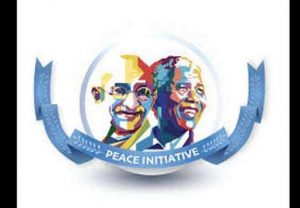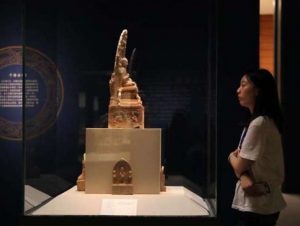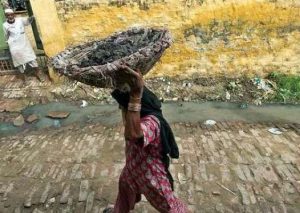Contemporary Buddhism in Bangladesh (167 pages)
By Dr. Sukomal Chaudhuri
Atisha Memorial Publishing Society
Calcutta, India, 1982
An English scholar, student, or reader interested in learning about Buddhism in Bangladesh may always feel the lack of authentic and reliable texts on the subject. The works published may be in learned journals beyond the reach or knowledge of a common reader, books out of print, or may be in Bengali language. Most of the available essays also contain the faults of repetition of well-known facts and lacking significant details. Dr. Egaku Mayeda, a Japanese scholar of Buddhist history, too felt the same deficiency in the twentieth century. While in a visit to Bengal, Dr. Mayeda requested Dr. Sukomal Chaudhuri, who had already published a good book in Bengali language on the history and cultural heritage of Buddhism in Bangladesh, to heal the urgent deficiency. As a result, today we have a principal book directly in English dealing with ‘contemporary Buddhism in Bangladesh’ – by Dr. Sukomal Chaudhuri. This book – an outcome of Dr. Chaudhuri’s excellent scholarship and hard work – is an improved version of his previous Bengali work. The book has sincerely been dedicated to Dr. Egaku Mayeda who also wrote its preface. Along with Dr. Sukomal Chadhuri, we too convey our adulations to Dr. Mayeda for his deep concerns for the Buddhists of Bangladesh.
I must confess that presently I am not in a position to write a good introduction of this book, partly due to my time constraints. It is also hard for me to make any judgment on a subject like the contemporary Buddhism in Bangladesh, myself having very meager knowledge of the same. Here my sole intention is to let our visitors know that there is such a book on Bangladesh Buddhism. This is therefore rather a notification than a review proper.
The book is divided into six chapters supplemented by six appendices as follows –
1. Introduction: History of Buddhism in Bangladesh.
2. Revival of Theravada Buddhism
3. Contemporary Buddhists of Bangladesh
4. Religious Festivals
5. Monastic Life
6. Doctrinal Buddhism and Popular Buddhism
Appendices
I. Buddhists of Chittagong
II. Buddhist Marriage
III. Details about Buddhist Funeral Rites
IV. Meditation on the 32 constituents of the Body.
V. Syllabus
VI. Marriage System of the Marammas
Some illustrations and photographs of contemporary Buddhist communities and some great personalities like Dr. B.M. Barua, H.H. Shilalankara Mahathera, H.H. Bisuddhananda Mahathera, H.H. Aggavamsa Mahathera, etc. (who have already passed away) in the first few pages of the book immediately draw the attention of readers and relate directly to the theme.
The author has given a bird’s eye view of the history of Buddhism in Bangladesh in the first chapter. The undivided Bengal (including Bangladesh and West Bengal of India) shared a common history in the past. The Pala kings, who ruled great portion of northeastern India for nearly six hundred years, had their kingdoms in the regions of present Bangladesh. However, after the separation of India in 1947, Bangladesh went under Pakistan and was known as East Pakistan. In 1971 (December, 16th), Bangladesh became an independent nation following a long war with West Pakistan (now Pakistan). This course of history had immense impacts upon the Buddhists of Bangladesh in identity formation, political participation, literary and religious practices, and international interactions. In the 1971 war, for instance, Buddhist monks played some significant roles as envoys of peace, seeking international support to stop unjust massacre caused due to war. All these form important segments of contemporary Buddhism in Bangladesh to understand what the Buddhists there have been through. When we talk about the history of or contemporary Buddhism in Bangladesh, it is not particularly about kings (that are in fact a succession from pre-Bangladesh history). It is more about the Buddhist people as a community whose fate has been largely shaped by political events that were beyond their control.
Regarding the unresolved question on the propagation of Buddhism in Bangladesh during the Buddha’s lifetime, the author has not given a definite conclusion. His conjectures on the possibility of the fact lean much towards ‘yes’ concluding with the statement “there should not have been doubt that Buddhism was spread in Bangladesh during the life-time of the founder.” Dr. Sukomal Chaudhuri has forwarded the references to Kaja?gala (modern K??kol – 18 miles south of R?jmahal hill in the East of India according to Cunnigham) in A?guttaranik?ya (vol.v.54ff.) and Majjhimanik?ya (vol.iii.298) and the mention of Pundravardhana in Divy?vad?na to support his proposition “if the Buddha and his disciples could come upto Kaja?gala whether they travelled further south and south east direction.” Elsewhere, (in an unpublished essay of mine on ‘references to Bengal in Pali literature’) I have shown venerable Va?gisa from Va?ga (Bengal) was well known among the contemporary disciples of the Buddha and Buddha’s references to va?ga in Anguttaranikaya (vol.iv) to substantiate the fact that the Buddha knew the region called Va?ga (Bengal). The Buddha had disciples from almost all parts of ancient India and certainly some (including Va?g?sa), whose names we would never know, were from Bengal. The Bengal known to the Buddha might have been the entire undivided Bengal or a part of present Bangladesh or West Bengal.
The author also gave a summarized version of the Buddhist kings who ruled Bengal and some other parts of India. An impressive account of the renaissance of Theravada Buddhism by the great monk His Holiness Saramedha Mahasthabir in early 19th century has been given in chapter two. Prior to that, after the fall of Buddhist kings in around 12th century A.D., barely the skeleton of Buddhism remained in the garb of Tantr?y?na heavily influenced by Hindu idolatry and opportunist priests who even practiced animal sacrifices. Thanks to H.H. Venerable Saramedha’s brilliant leadership and the noble patronage of H.E. Chakma Queen Kalindi Rani, within few decades, drastic change took place among the Buddhists of Chittagong. Authentic Buddhism was restored by conducting ordination ceremonies following Therav?da vinaya as preserved in Myanmar for centuries. This reformation in Chittagong, then a part of British India was immediately followed by other states of India. Some of the most significant events from that period of renaissance until the time of writing the book in newly formed Bangladesh have been given in brief. The Sangharaja (Supreme patriarch of the Buddhists) of that time was His Holiness Venerable Shilalankara Mahasthabir who served Bengali Buddhists with his prudent spiritual guidance and erudite literary publications for more than twenty five years as the eighth Sangharaja and more than seventy years as a Buddhist monk. International Buddhist community has a great deal to learn from the great spiritual and literary contributions of these great Sangharajas of Bangladesh.
In chapter three, the author briefly introduces several Buddhist communities mainly Barua, Chakmas, Si?ha-Baruas, and Marmas with some account of their origin, history, languages, inhabited places, belief systems, etc. Historical origin of these communities is lost in uncertain conjectures almost with every case. Are the Baruas of Chittagong survivors of ancient Magadhan Buddhists who fled to hilly regions to escape forced conversion by Brahamanic kings and Mohamedans? What is the history of the term Barua? Among various places named Champa or Champak in Myanmar, Bangladesh, and Bihar (in India), which Champak is the original home of Chakmas? How to explain the fact of Chakmas and Tanchangyas who are anthropologically Mongolians or Tibeto-Burmans speaking a branch of modern Indo-Aryan dialect, whereas Marmas have retained their variation of Arakanese? These are some interesting questions that Dr. Chaudhuru has touched upon in brief, but require much in-depth study. Dr. Chaudhuri’s treatment of Baruas and Si?ha-Baruas, who are generally believed to be the same community, under different subheadings deserves attention.
The most distinctive features of the Buddhists in Bangladesh are their religious festivals and incorporation of Buddhist doctrinal values in their family and social lives. All throughout the year the Bangladeshi Buddhists define their important occasions like birth of a child, marriage, funeral, New Year ceremony etc. in connection to Buddhism. Every Buddhist family has a special place like an altar at home –– with Buddha image for daily obeisance. Apart from these, they developed significant festivals and ceremonies on special occasions like different full-moon days. The author has given a very good account of these festivals and ceremonies in the fourth chapter. The fifth chapter gives an account of the life of a Buddhist monk, their daily routines, monastic system, and how they connect to the lay people in ceremonies like almsgiving, funeral rites, etc. The final chapter gives an account of the fundamental Buddhist doctrines followed by the Buddhists in Bangladesh. The appendices attest much important facts to the main thesis of the book. It is noteworthy that, in order to give an idea of their Buddhist educational practices, Dr. Sukomal Chaudhuri has given the then syllabus followed by Buddhist students in Buddhist studies centers around the country.
From this cursory account one may get an understanding of the great significance of the book ‘Contemporary Buddhism in Bangladesh.’ Certainly there may be a lot more to supplement to the facts provided by Dr. Sukomal Chaudhuri. Each of the Buddhist communities (including those not mentioned in the book), for example, deserves to be independently studied with methodological supports from professional Anthropologists, Historians, Sociologists, etc. But, one must not forget that this work has been done single handedly by Dr. Sukomal Chaudhuri. Therefore one must not expect it to be hundred percent perfect, especially because it is among the first attempts to write on Bangladeshi Buddhists in English (during the first decade of independent Bangladesh’s history). He had very intimate connection to the Bengali Buddhists, of which he himself is a member. Yet in order to be accurate in his assertions and interpretations of facts he visited traditional Buddhist places, stayed with people there, and interviewed them – thus increasing the credibility of the facts in his book. The book also provides some important titles on Buddhism in Bangladesh in the Bibliography. It is, therefore, a great support for future researchers to begin their work on the subject of contemporary Buddhism in Bangladesh. We acknowledge our thanks to the excellent and landmark contribution of Dr. Sukomal Chaudhuri.








